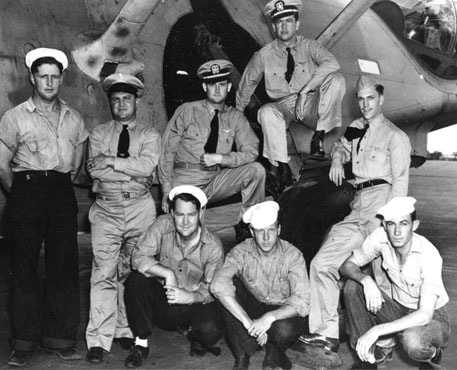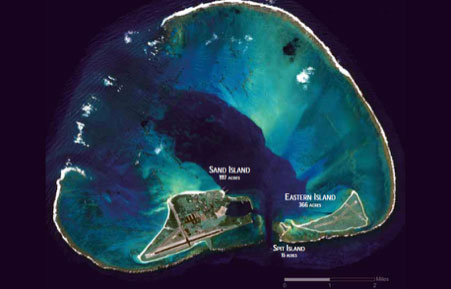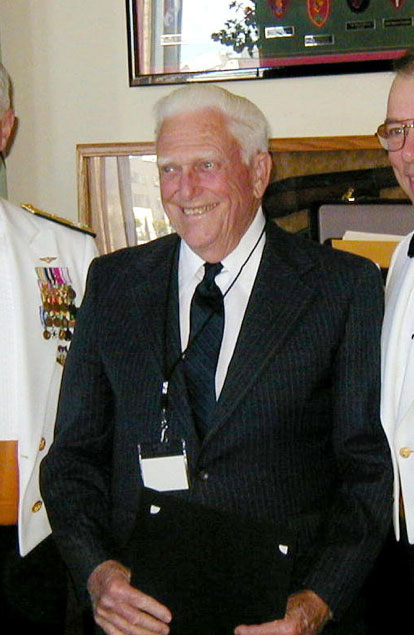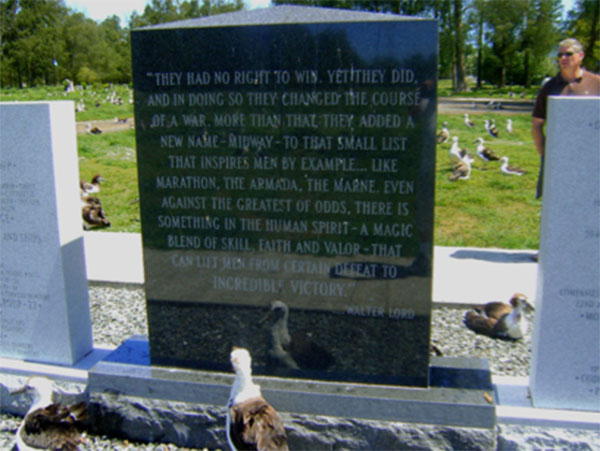Golden Pelicans
All the ceremonies surrounding the 75th anniversary of the Battle of Midway are kicking off today. The vast distances involved meant that the epic struggle would play out over a week. In the parlance of today’s warfighters, the “battlespace had been shaped” by the codebreakers of Station Hypo, the information had been passed cogently to the Commander of the Fleet, Chester Nimitz by Intel chief Eddie Layton, forces had been allocated and deployed after heroic efforts by the military and civilian workers at Pearl Harbor Naval Shipyard. The haze-gray combat forces were moving to engage the enemy. The die was cast, and all the Spooks could do in their Dungeon under the 14th Naval District Headquarters was to wait, and hope their analysis had been right.
The celebrations will start today. The Dungeon will be open to a select group of visitors, since it was a space controlled by the Bureau of Reactors and normally under tight control. I understand that is going to change, and that is for the best. Our pal Mac Showers would appreciate people being able to see where he sat under the watchful gaze of Joe Rochefort, and adjacent to retired submariner and pulp fiction writer Jasper Holmes, and a spitwad shot distance from Tommie Dyer, who had been working the Japanese code problem since the mid-1930s.
The Navy knows the curse of distance, and hence the Department’s major observation is going to be the largest of them, and not in Hawaii. The Chief of Naval Operations will travel to San Diego for a ceremony on the flight deck of my first warship- the ex-USS Midway ar her berth in that lovely harbor. All the brass is going to be there as well to commemorate the greatest maritime victory since Trafalgar.
It is a little bittersweet. I had intended to be on a jet headed west around this time today, heading not for the Golden State but for the lovely isle of O’ahu to celebrate with my son, and the various ghosts I have acquired through the years.
Some of them are anonymous, or at least unknown to me and my shipmates who shared the Haunted Bunk Room at the Dispensary and temporary morgue on Ford Island. And of course the one’s I knew best over a decade of conversation at the bar of the Willow Restaurant. It now seems like a magical time in life. I even had tickets to be at the 70th anniversary with Mac and his family, but I wound up in the hospital instead with the firm admonition not to sit in one place for very long due to the risk of blood clots.
So, be prepared over the next few days to celebrate history and courage. You know, the characteristics so common in ordinary Americans, and so rare here in the Nation’s Swamp. I thought I would start the cycle with an account of a visit to Midway itself, and the remembrance of one of the heroes, the lone survivor of Torpedo Squadron EIGHT, Ensign George Gay. I met George once. He was a good guy, and I bought his book, not knowing the connection he had to Station HYPO- the perfect cover.
More on that in the next few days.
With the Golden Pelicans at Midway

(The crew of the PBY Catalina that sighted the Japanese fleet on the eve of the Battle of Midway).
My 92-year-old drinking buddy Mac was one of the last survivors, and considering the significance of the 70th anniversary of the great battle, and the fact that so few of the participants are left, Mac is going to take his family out there. My boss Jake has been asked to make a speech, along with Mikey, the Director of National Intelligence, who I worked for a couple times in his amazing career.
Jake had an interesting story and he began to tell it as he wagged a finger at Liz-with-an-S behind the bar for another glass of IPA. He had made one-star while on the USCINCPAC Staff, and was the “duty Admiral” one weekend when a special flight was laid on to scatter the ashes of ENS George Gay, (the “Sole Survivor of Torpedo EIGHT”) from the CINC’s dedicated P-3 Orion aircraft on the waves where the battle was fought so long ago. After he was shot down with the rest of his squadron, he spent an eventful day amid the burning Japanese fleet. It was Gay’s colorful eyewitness account of the sinking of three IJN Carriers that electrified the nation on the cover of Life Magazine.
Of course, it wasn’t completely true. Gay’s story was useful in that it provided an alternative explanation to why Admiral Nimitz knew so much about the devastating results of the battle rather than disclosing that we were reading their messages. George had a colorful story that did not include the details of the vulnerability of the JN-25 coding system used by the Japanese.
I met ENS Gay at one of the big EAA fly-ins at Oshkosh years ago, and he signed a copy of his book about the battle for me, “Sole Survivor.” He actually made LCDR before the war was over, and despite a follow-on career flying for Trans World Airways, he would always be “ENS Gay,” the only one of thirty squadron mates to survive the battle. I wish I had known the real story and asked him to hear it direct from the horse’s mouth.
Jake noticed two older gentlemen who were on the CINC’s plane. For the life of him, he said he could not recall their names, but the event of the day were interesting. A stone was dedicated at Midway, and a harrowing event followed on a long flight 700 miles to the west as an aircrewman attempted to deposit ENS Gay out the hatch. He asked me to check out the identities of the two older men- he thought they might have been the pilot and co-pilot of the PBY whose contact with the Japanese provided plausible cover for the JN-25 intercepts that enabled Mac and station HYPO to offer Chester Nimitz the chance to bushwhack the Japanese.
The flight Jake was on covered the thousand nautical miles to the northwest of O’ahu. Midway, outer rampart of the Hawaiian Island chain, had been recognized to be strategic as early as 1867 when the Secretary of the Navy, Gideon Welles, directed that Brooks Island, as it was then known, be claimed and surveyed for the United States. In 1869, Congress appropriated $50,000 for dredging an entrance channel to the lagoon. Over time, the atoll became a relay station for the trans-Pacific cable that linked the American colony of the Philippines to the Mainland.
Pan Am used the lagoon for a refueling station, and created a modest R&R and hotel facility in Mid-Pac. Pan Am was a great institution. I am sorry it is gone, though we saw remnants of their Pacific operations all over in our various deployments, including the ones in the Navy housing Area at Pearl City on Oahu. I bought a copy of “Shattered Sword,” the latest in the long series of the history of the battle by Parshall and Tully, using extensive Japanese sources to re-familiarize myself with the details..
I personally found “Joe Rochefort’s War” by Elliott Carlson published later to be much more approachable and human scale- and of course I feel like I almost know him from the stories from Mac.
Anyway, there are remarks to be drafted and stories to be told, so I thought I would take a whirl through the fight and get oriented so I could ask some pertinent questions to Mac, who was still alive and sitting at the Willow Bar, since he lived the experience.
By 1942, Midway had become the front line of the expanding area of the Japanese-controlled Pacific Ocean. Wake island, the next of the strong of pearls across the broad blue waves, was a thousand nautical miles to the WSW. It was occupied by the Imperial Army in the opening days of the Pacific conflict, the Navy and Marine Garrison fighting hard before surrendering to overwhelming force.
The American spine had stiffened in the months of reeling defeat since the attack on Pearl- and the work of Station Hypo contributed to the ability to put maximum fire-power at the point of attack. The fight at Coral Sea was inconclusive, but shored up the route of the vital re-supply lines to Australia.
In May 1942, Admiral Isoruku Yamamoto, commander in chief of the Japanese Combined Fleet, was prepared to shift his offensive operations north and east from Coral Sea and knock out the USN once and for all.
His staff devised an intricate plan called Operation MI, to draw out the U.S. Pacific Fleet by attacking Midway. Using Midway as bait and gathering a vast naval armada of eight aircraft carriers, 11 battleships, 23 cruisers, 65 destroyers and several hundred fighters, bombers and torpedo planes, Yamamoto planned to crush the Pacific Fleet once and for all.
He would ambush the mauled American Fleet at Midway Island, and then secure a base for land-based aviation to regularly strike Pearl Harbor.
Alerted by his code-breakers that the Japanese planned to seize Midway, Admiral Chester W. Nimitz, commander in chief, Pacific Command, flew to the atoll on May 2, 1942, to make a personal inspection. He wanted to size up the defensive posture and the character of his Navy and Marine commanders on scene. Commander Cyril T. Simard, USN, was the air component commander, and Lt. Col. Harold D. Shannon was the Marine ground commander.
They gave the Admiral the grand tour.
Following his personal inspection, Nimitz took Simard and Shannon aside and asked them what they needed to defend Midway. They told him their requirements.
“If I get you all these things, can you hold Midway against a major amphibious assault?” Nimitz asked the two officers. “Yes, sir!” Shannon replied.
It was good enough for Nimitz, who returned to Oahu. On May 20, Shannon and Simard received a letter from Admiral Nimitz, praising their fine work and promoting them to captain and full colonel, respectively. Then Nimitz informed them that the Japanese were planning to attack Midway on May 28; he outlined the Japanese strategy and promised all possible aid.
There were issues in the massive build-up. On May 22, a sailor accidentally set off a demolition charge under Midway’s fuel farm. The explosion destroyed 400,000 gallons of aviation fuel, and also damaged the distribution system, forcing the defenders to refuel planes by hand from 55-gallon drums.
All the while the Marines continued digging gun emplacements, laying sandbags and preparing shelters on both islands.
Barbed wire sprouted along Midway’s coral beaches. Shannon believed that it would stop the Japanese as it had stopped the Germans in World War I. He ordered so much strung that one Marine exclaimed: “Barbed wire, barbed wire! Cripes, the old man thinks we can stop planes with barbed wire!” The defenders also had a large supply of blasting gelatin, which was used to make anti-boat mines and booby traps.
On May 25, while the work continued, Shannon and Simard got some good news, courtesy of Joe Rochefort’s band of code-breakers at Station Hypo. The Japanese attack would come between June 3 and 5, giving them another week to prepare.
That same day, the light cruiser St. Louis arrived, to deliver an eight-gun, 37mm anti-aircraft battery from the Marine 3rd Defense Battalion and two rifle companies from the 2nd Raider Battalion. Beginning on May 30, Midway’s planes began searching for the Japanese. Twenty-two PBYs from Lt. Cmdr. Robert Brixner’s Patrol Squadron 44 (VP-44) and Commander Massie Hughes’ VP-23 took off from Midway lagoon, then headed out in an arc stretching 700 miles from Midway in search of the main body of the invasion force.

(Midway Island- actually three small islands in a middling-large lagoon. Now administered by the Fish and Wildlife Service, the island was a key mid-Pacific naval bastion for a century. Our pal Sam Cox actually owns all the military stuff on the islands as Director of Naval History and Heritage. He told me he was going to be there this week, and I envy him.)
By June 1, both Sand and Eastern islands were ringed with coastal defenses. Six 5-inch guns, 22 3-inch guns and four old Navy 7-inch guns were placed along the coasts of both islands for use as anti-aircraft and anti-boat guns. As many as 1,500 mines and booby traps were laid underwater and along the beaches. Ammunition dumps were placed all around the islands, along with caches of food for pockets of resistance and an emergency supply of 250 55-gallon gasoline drums.
Six new Grumman TBF torpedo bombers arrived on the island that day, commanded by Lieutenant Langdon K. Fieberling. None of the TBF pilots had ever been in combat, and only a few had ever flown out of sight of land before. The TBF would later be named Avenger in honor of its combat introduction at Midway
Midway had practically everything it needed for its defense. Along with the 121 aircraft crowding Eastern Island’s runways, Midway had 11 PT-boats in the lagoon to assist the ground forces with anti-aircraft fire. A yacht and four converted tuna boats stood by for rescue operations, and 19 submarines guarded Midway’s approaches.

(CAPT Jack Reid, USN-Ret.)
On June 3rd, 1942, a VP-44 Consolidated PBY commanded by ENS. ”Jack” Reid, was assigned sector search west by southwest, which was in the general area for a possible encounter with the IJN twin- engine“Betty” bombers that flew out of captured Wake Island. The crew hoped for an encounter with one of the Japanese aircraft. The night before one of the crew members had traded some beer for five new explosive .50 caliber shells from a B-17 crew.
The ordnancemen on the crew had loaded them on the port waist gun.
The flight came to the end of their outbound 600 mile leg with no sightings. The crew urged Jack Reid to go further to see if they couldn’t make contact with a “Betty.” Jack checked with navigator Bob Swan and was assured that they still had plenty of fuel to go another 20 or 30 minutes on the present course. Jack agreed to the plan and told Bob,” just give me as heading when we get to the end of the time limit.”
The flight continued on for the allotted time and as Bob was about to give Jack the new heading for the dogleg and at that instant Jack spotted specks on the horizon. He gave the binoculars to the second pilot Gerald Hardeman saying: “Are those ships? I think we’ve hit the jackpot.”
Hardemen concurred. Moments later John Gammell, in the nose turret, sang out “Ships dead ahead, about 30 miles dead ahead.” a radio message was immediately sent to Pearl Harbor saying, ”Sighted main body”, minutes later, a second message, ”Bearing 262, distance 700 miles.”
Nimitz’ headquarters at Pearl Harbor and Fletcher’s carriers also received Reid’s “Main Body” message. Since they expected Nagumo to be coming from the northwest, not west/southwest, this message briefly posed a problem. But Nimitz stuck with his intelligence forecast, and radioed back to the carriers “The force sighted is not, repeat not, the Main Body.”
That is the essence of this story, the necessity of covering the vulnerability of the codes with plausible deniability.
Jack Reid scouted the force for another two hours, not knowing which part of the elephant of the huge Japanese formation he was observing. He kept the Catalina at low altitudes and came up from different positions, counting the sightings at each one and radioing the results. The long wakes in the ocean from the armada led him to either port or starboard of the ships. He knew full well, if detected, they would be hit by swarming Zero-sen fighters.
The force Jack’s crew had sighted consisted of 17ships, battleships, cruisers, destroyers, and transports headed for Midway. It was not the target that Joe Rochefort predicted carried the largest threat to the island- the fast carriers.
Commander Robert A. Swan, of Santa Rosa, California, was the navigator on 44-P-4. He always had a familiar smile, with a personality to match. A Naval Reserve PBY pilot in 1942, Bob was the navigator on Jack Reid’s Catalina.
44-P-4 landed back at Midway with little fuel to spare, and one of the two massive engines sputtered out after they landed in the lagoon. When asked why they were able to stay aloft for an additional 3 hours, Bob replied, “Raymond Derouin (the plane captain) has three dependents-a wife and two daughters. He always puts in an extra 50 gallons for each one.”
Bob continued in patrol aircraft for the remainder of the war and stayed in the Naval Reserve after its conclusion, retiring as a commander.
VP-44’s greatest contribution to victory had been made, but the battle was only now being joined. On June 4, Reid and Hardeman flew more than 14 hours, again providing important contact reports. Indeed, he had become an important set of “eyes” for the US Fleet. His PBY was attacked by Zeros and by AAA on a Japanese cruiser, but Jack got his aircraft and crew to safety up in the clouds. Later he landed in the lagoon at Midway, and as he taxied toward Sand Island, one of his engines sputtered out for lack of fuel. Nonetheless, he was up and flying the next day, searching the Pacific for lost pilots and crews.
Jack Reid stayed in the Navy after the war and retired with more than 30 years services as a Captain, setting up his home in Aptos, CA.
The last members of 44-P-4 have passed on. Jake got a chance to meet them, and shoot the shit in the plane on the long flight west. I wish I had the chance, but you have to take what you can get. I still think about ENS Gay, and his card table at the Oshkosh Air Show, and the way he returned to the Battle of Midway from the back of the CINC’s plane.

(Battle of Midway National Memorial on the atoll).
On September 13, 2000, Secretary of the Interior Bruce Babbitt designated the lands and waters of Midway Atoll National Wildlife Refuge as the Battle of Midway National Memorial, “so that the heroic courage and sacrifice of those who fought against overwhelming odds to win an incredible victory will never be forgotten.”
The monument reads, in part: “They had no right to win. Yet they did, and in doing so, changed the course of a war.”
This is the first National Memorial to be designated on a National Wildlife Refuge.
Numerous historic sites portraying man’s history on the islands since the early 1900’s are protected by the Fish and Wildlife Service, including several World War II defensive positions that were designated a National Historic Landmark in 1986. Sadly, the structures on the island are slowly crumbling, since the primary mission of the island is to keep it pristine for the flora and fauna.
The murals from the old Base Theater are on loan to the Pacific Aviation Museum on Ford Island. They are impressive, and it is better to have them where they can be seen, rather than on Midway Island itself. The Fish and Wildlife people do not want us to scare the birds.
Copyright 2017 Vic Socotra
www.vicsocotra.com
